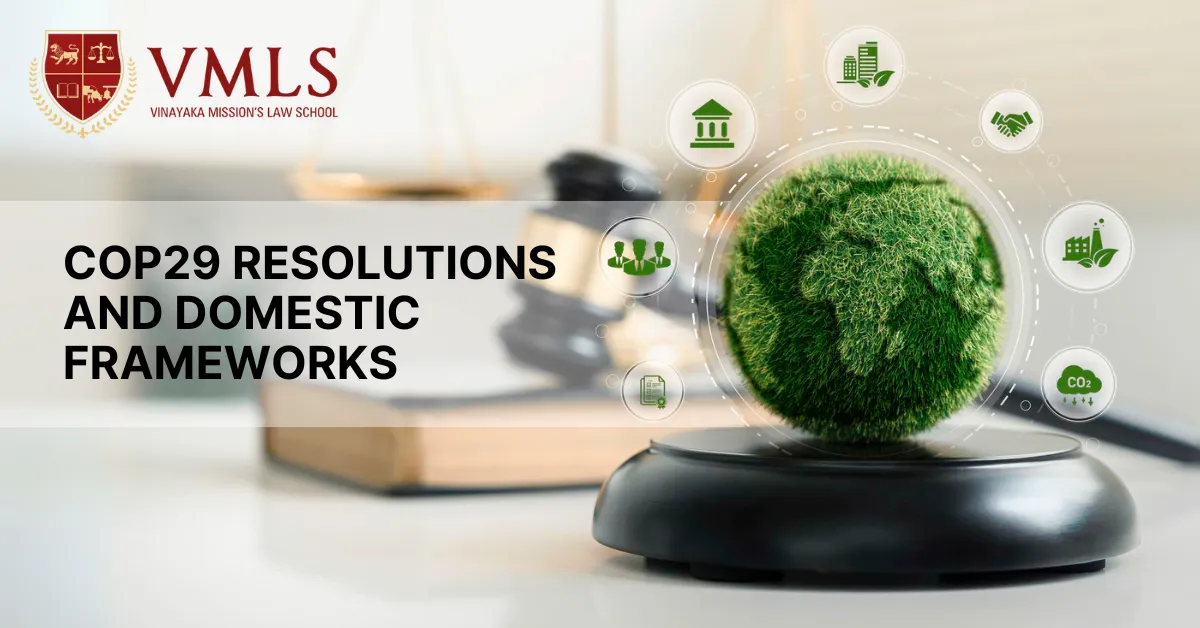Jan 27, 2025
0 Views

As global environmental challenges intensify, the importance of climate finance has reached a pivotal point. During COP29, the international community reiterated its dedication to increasing climate finance, targeting a minimum of USD 1.3 trillion each year by 2035. India, as one of the largest developing economies and a significant contributor to climate action, is in a unique position to capitalize on this momentum. By aligning global initiatives with local policies, India can take the lead in utilizing climate finance for sustainable development.
Climate finance involves funding from various sources, including public, private, and alternative channels, aimed at supporting efforts to mitigate and adapt to climate change. The resolutions from COP29 stress the importance of increasing climate finance flows to developing countries, which are estimated to require between USD 455–584 billion annually for mitigation and USD 215–387 billion for adaptation. They also call for reforms in multilateral financial systems to lower barriers such as high capital costs and complicated application processes. Additionally, there is a strong emphasis on enhancing the mobilization of public finance and promoting non-debt-inducing options like grants and guarantees. For India, these commitments offer a chance to tackle its climate vulnerabilities while also driving economic growth.
India's approach to climate finance has seen significant changes over the years. The country has set ambitious climate targets as part of its Nationally Determined Contributions (NDCs), aiming to reduce emissions intensity by 45% by 2030 and achieve 50% of its cumulative electric power capacity from non-fossil fuel sources. To reach these goals, India needs substantial financial resources, estimated to exceed USD 2.5 trillion by 2030. On the domestic front, the Reserve Bank of India (RBI) has rolled out green bond guidelines to encourage investments in renewable energy, energy efficiency, and sustainable projects. Additionally, institutions like the India Infrastructure Finance Company Limited (IIFCL) are backing green infrastructure initiatives, such as solar parks and wind energy. To enhance transparency, SEBI’s Business Responsibility and Sustainability Reporting (BRSR) requires listed companies to disclose their Environmental, Social, and Governance (ESG) metrics, ensuring that corporate actions align with climate objectives. Furthermore, initiatives like the National Investment and Infrastructure Fund (NIIF) and collaborations with global climate funds strengthen India’s financing capabilities.
The alignment of COP29 resolutions with India’s domestic policies creates a promising environment for innovations in climate finance. A major focus is on scaling renewable energy, highlighted by India’s ambitious goal of reaching 500 GW of renewable energy capacity by 2030. Sovereign green bonds and foreign direct investments (FDIs) are essential for directing international funds into local projects. Additionally, boosting adaptation finance is vital, as India faces significant vulnerabilities to climate change that require more investment in flood management, drought mitigation, and resilient agricultural practices. The emphasis on adaptation finance at COP29 presents a chance to enhance public funding for rural and coastal communities.
Improving ESG and climate risk reporting is a vital area for growth. Better ESG disclosures, as required by SEBI, will enhance transparency and draw in ethical investors. Developing strong climate risk assessment tools can also assist Indian companies in tapping into international green finance. Creative financial instruments like carbon markets, green bonds, and blended finance can help reduce the risks associated with investments in climate initiatives. Local currency financing, as suggested in COP29, can help domestic players manage foreign exchange risks.
While there are opportunities, several challenges persist. Limited access to affordable funding discourages small and medium enterprises (SMEs) from embracing green technologies. Institutional hurdles, such as protracted approval processes for international climate funds, slow down project implementation. Additionally, a lack of capacity in structuring and managing climate finance projects complicates execution. Tackling these challenges requires a comprehensive strategy. India needs to align its national policies with COP29 resolutions, focusing on equity and differentiated responsibilities. Initiatives aimed at building capacity are crucial for training stakeholders in the effective design, implementation, and monitoring of climate finance projects. Enhancing partnerships with multilateral development banks and global funds can help attract concessional finance, while regulatory improvements can simplify approval processes and encourage innovative financial instruments.
India's success in achieving its climate and development goals will largely depend on its ability to utilize climate finance effectively. By building on the resolutions from COP29 and enhancing its domestic frameworks, India can tackle its climate issues while positioning itself as a global leader in sustainable development. The outlook for climate finance in India is bright, as long as it pairs ambition with practical strategies.
Several students across India are choosing law as a career due to the various benefits it offers.
The 3-year LLB (Bachelor of Legislative Law) programme is an undergraduate programme designed to cater...
Vinayak Mission's Law School (VMLS) is one of the best law schools in India and is being mentored by O. P. Jindal Global...
In India, law is seen as a noble career option, and the number of students interested in pursuing law is increasing.
If you are willing to work in a legal advisory firm, judiciary, or as a lawyer, then pursuing a law degree plays...
CLAT is a national-level entrance exam, and it stands for Common Law Entrance Test. Many top law universities in India.
Many students are developing their interest in law and several fields related to legal studies. After the 12th exam...
Many students in India choose law as a career due to the various benefits this field offers. Although there are several..
LLB stands for Bachelor of Legislative Law, which includes understanding several legal aspects.
Law is one of the most sought-after careers in India. So, having an LLB degree from a good law college helps students...